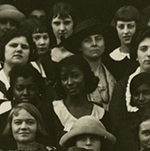 University Library
What She Said
University Library
What She Said
Part II: Women Together
Part III: Issue Spotlights
 University Library
What She Said
University Library
What She Said
Part II: Women Together
Part III: Issue Spotlights
At the turn of the 20th century, as a new generation of women joined the suffrage movement, the divisions of previous decades diminished. Calling themselves "suffragettes," these younger women were more educated than their suffragist predecessors, more likely to work outside the home, and tended to be more active and outspoken. Forming a new national organization, the National American Woman Suffrage Association, they abandoned the state-by-state strategy.
In the face of opposition from high-profile politicians, including President Woodrow Wilson, suffrage activists carefully honed their public image, dressing respectably in case they were photographed, and wearing sashes and rosettes in the movement's colors: purple for loyalty, gold for enlightenment, and white for purity. Despite arguments by Stanton and others that attention to fashion was acceptance of female oppression, by the 1910s a feeling of unity had developed across the suffrage movement in the face of harassment, arrest, and other adversities.
Suffrage activists organized numerous marches and demonstrations. At the Woman Suffrage Parade of 1913 in Washington DC lawyer Inez Milholland, dressed in white and riding a white horse, led a procession consisting of nine bands (one comprised entirely of women), five mounted brigades, 26 floats, and approximately 8,000 marchers. These efforts ultimately culminated in the 19th Amendment passing the House on May 21 and the Senate on June 4, 1919. Wisconsin, Illinois, and Michigan were the first states to ratify it six days later, and Tennessee was the 36th and last in August 1920, when a woman's right to vote became formally enshrined in the US Constitution.
Case 6, Aftermath and Impact, is to your right on the east wall of the gallery.
1
Program, "Forty-Fifth Annual Convention: National American Woman Suffrage Association" in Washington, D.C., November 29-December 5, 1913Women's Suffrage Collection
2
Stereocard, "Suffragette Parade--G. Marshall, Mrs. Richard Burleson; Herald, Miss Inez Milholland; and other Prominent Workers on Horseback--March 3, 1913, Washington, D.C."Women's Suffrage Collection
3
Postcard, "Liberty and Her Attendants (Suffragette's Tableau); in front of Treasury Bldg. March 3, 1913, Washington, D.C."Women's Suffrage Collection
4
Proposed Constitution for the National American Woman Suffrage AssociationWomen's Suffrage Collection
5
Constitution of the National American Woman Suffrage Association, Adopted by the convention at Philadelphia, November 1912Women's Suffrage Collection
6
19th-Century Dress with Reproduction Suffrage Sash and RosetteBaldwin-Shaffner Family Collection
7
Alice Duer Miller. Women are People! New York: Gordon H. Doran Company, 1917.JF 855 M65 1917
8
Marjorie Shuler. For Rent--One Pedestal. New York: National Woman Suffrage Publishing Co., 1917.PS 3537 H98 F67 1917
9
Justina Leavitt Wilson. Suffrage Argument: Outline for Speech or Debate. New York: National Woman Suffrage Publishing Company, Inc., 1917.Women's Suffrage Collection
10
Carrie Chapman Catt. Woman Suffrage by Federal Constitutional Amendment. New York: National Woman Suffrage Publishing Co., Inc., 1917.KF 4895 Z9 C3 1917
11
Broadside, "Women Voters, Vote Against Wilson, He OPPOSES a National Suffrage Amendment…" National Woman's Party, circa 1916Journal of a Trip from Liverpool to San Francisco
12
Broadside, "Women Voters, Vote Against Wilson, He Opposes National Woman Suffrage…" National Woman's Party, circa 1916Women's Suffrage Collection
